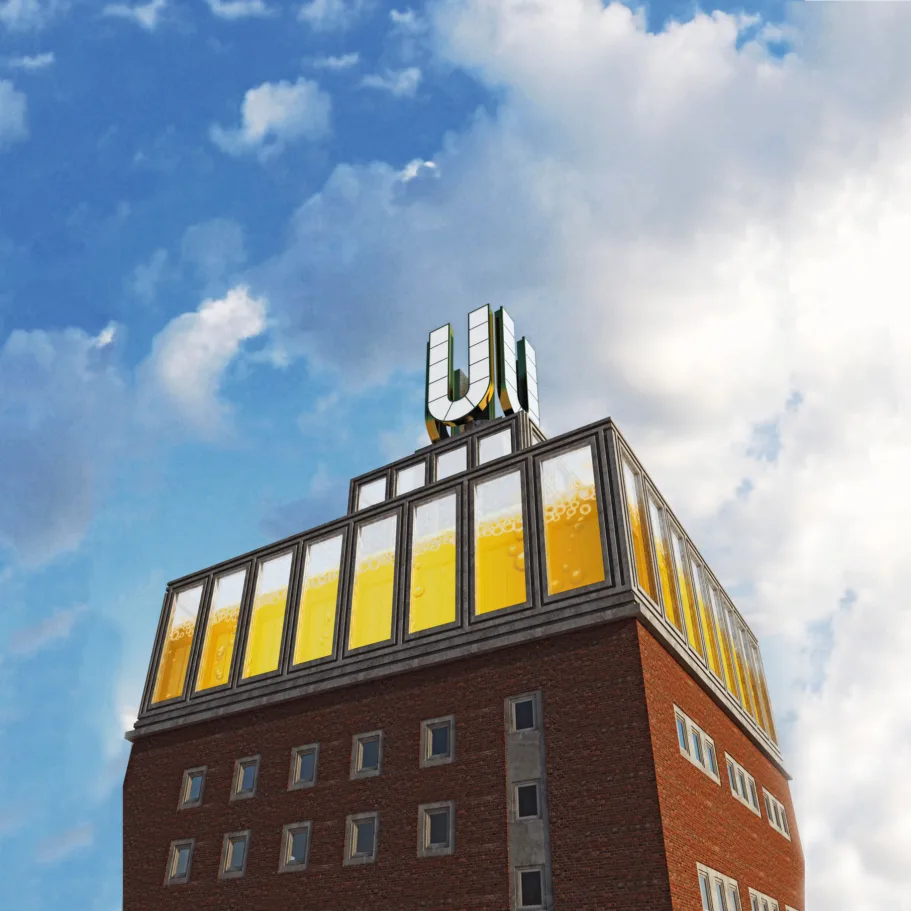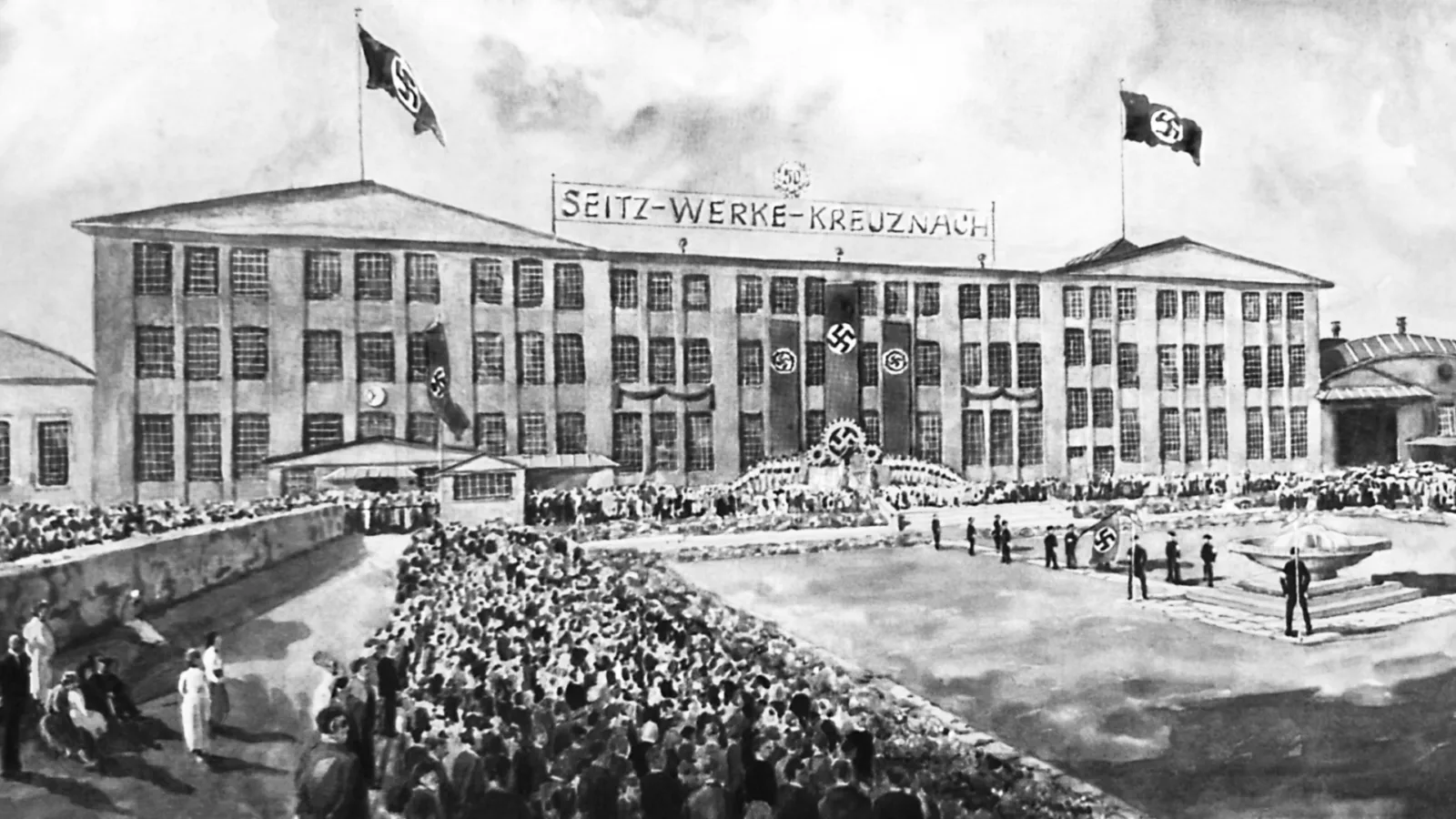
War economy and ruin
The 1930s and 1940s in industry were also dominated by National Socialism and war. The 1930s and 1940s in industry were also dominated by National Socialism and war. It was a time of patriotism and then of devastation, at the end of which everybody had to start anew.
During the rule of the National Socialists the economy had the task of controlling and mobilizing society. On the one hand it had to satisfy the needs of the population so that the propaganda of the Third Reich could take its desired effect. On the other it had to create the right conditions for the planned war. Within just a few years of Hitler’s rise to power unemployment dropped from six million in January 1933 to a yearly average of under one million in 1937. The regime claimed that the fact that the economy and the labor market in Germany had recovered much faster from the Great Depression than that of the other industrial nations was a notable outcome of its National Socialist welfare policies. The focus then quickly and permanently shifted to rearmament.
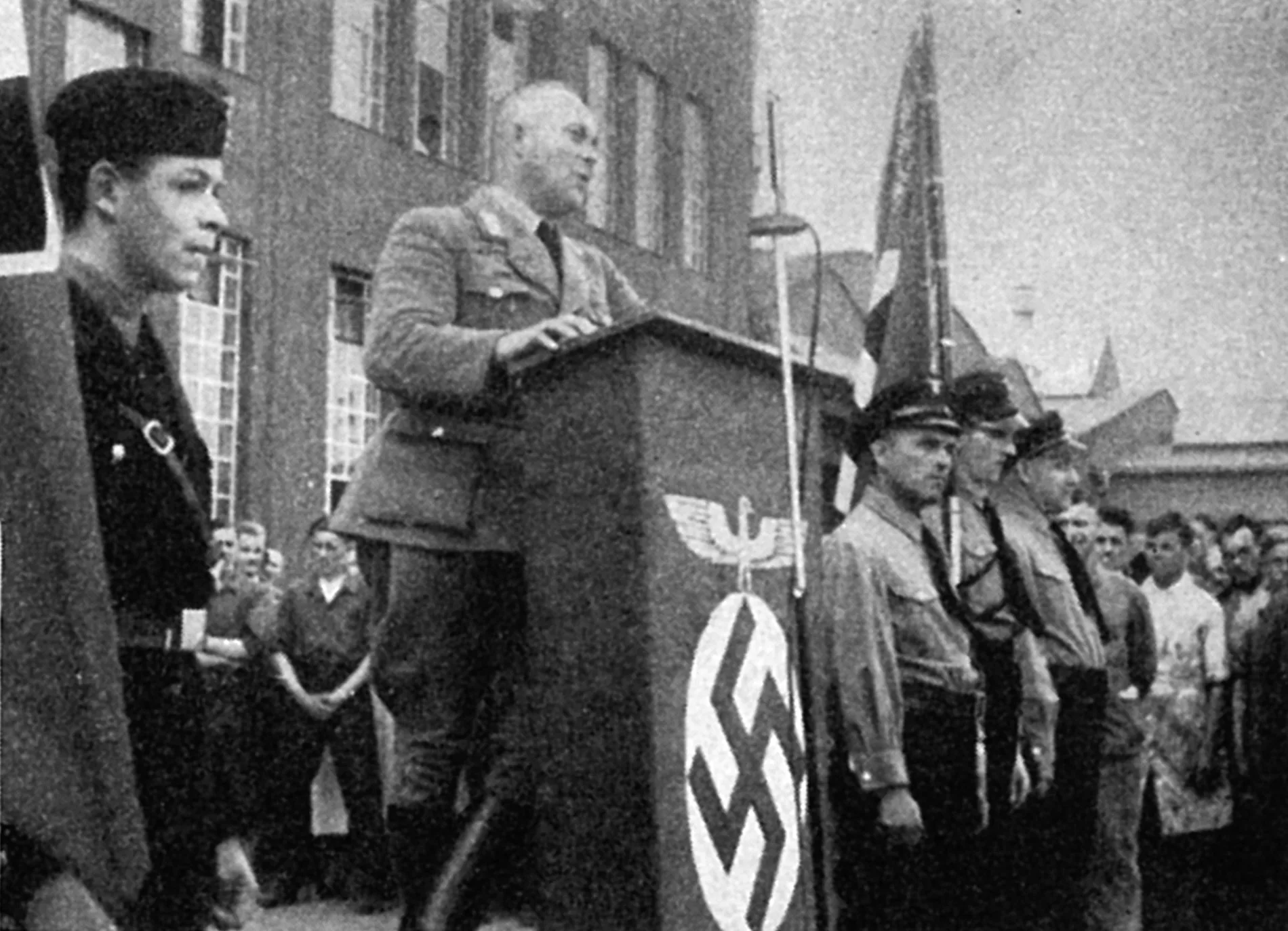
In recognition of its contribution to the “model training of apprentices” Reichsorganisationsleiter Robert Ley presents the Seitz-Werke with the “proficiency award for exemplary vocational education”.
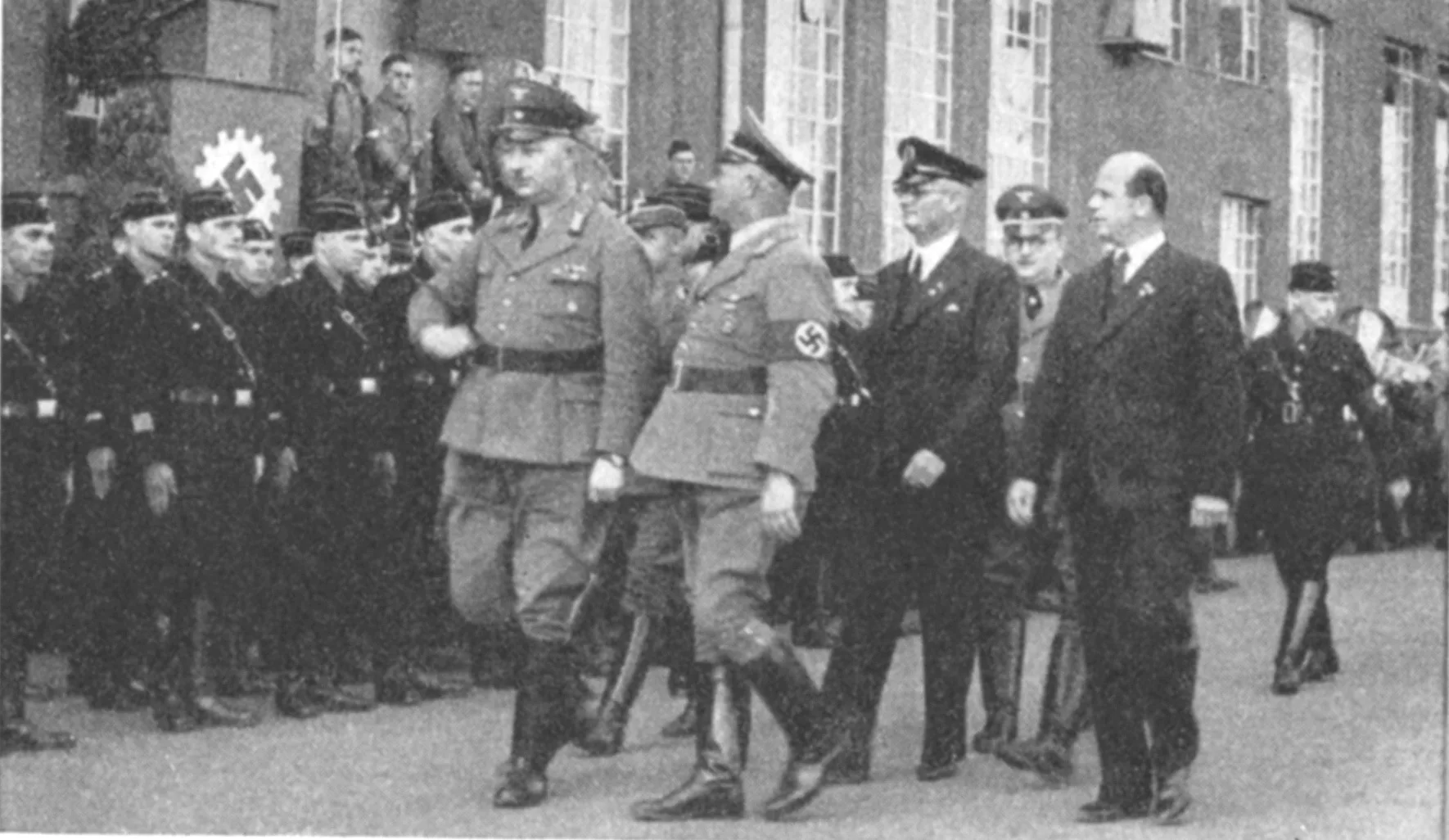
Nazi officials march past the Seitz-Werke workforce assembled in rank and file for the occasion.
In light of the debate
about compensation for the victims of the Holocaust and former forced laborers many major German companies have had their company history during the Third Reich revised by historians of renown.
Ready for action
In a memorandum to what was known as the Four Year Plan Hitler wrote in 1936: “If we are not able within the shortest time to make the German Wehrmacht [...] the first army in the world, Germany will be lost!” For him this meant the following: “I. The German army must be ready for action in four years. II. The German economy must be ready for war in four years.” Many entrepreneurs supported their country’s war effort of their own free will, either out of a sense of patriotism or from fear that they would forfeit their assets should the war be lost – and not without good reason, as the Great Depression of 1929 had just shown.
Little documented chapter
In how far companies collaborated with the regime – whether voluntarily or because they were forced to – is nowadays not always easy to ascertain. In the case of large concerns in particular the company’s history is often well documented and researched, also including the less glorious episodes in its past. With medium-sized and family businesses, however, whose owners often didn’t belong to the upper echelons of Germany’s economic elite, the situation is frequently different. Hardly any professionally maintained archives exist; pertinent documents have been lost forever and the memories of a time which is perhaps generally not gladly remembered have long faded.
It’s thus pure luck to find publications which provide an insight into this period of German history. When in the summer of 1937 the Seitz-Werke in Bad Kreuznach festively celebrated its 50th anniversary, for instance, a brochure was issued which painted a picture of a truly cosmopolitan company – right up to the information that the Seitz-Werke “maintains its own production sites overseas and in several European states, 53 branches, foreign subsidiaries, agencies and general offices all over the world”. A second brochure published a little while later invites visitors on a tour of the factory. This contains images of the anniversary celebration which show the factory decked out in Nazi flags. Guests of the event are listed as “all factory employees with their wives, top officials of the Party and the public authorities and a number of personal friends of the house of Seitz”. Later on the presentation of the “proficiency award for exemplary vocational education” by Reichsorganisationsleiter Robert Ley is depicted with the remark that it “goes without saying” that “each individual” takes active part “in the fates of the people and the Reich, in the building of Germany by our Führer and in everything which goes on in the world around us”.
It may be a coincidence that documents like these no longer exist for the other companies which later merged to form KHS – in any event it doesn’t say anything about their political orientation.
The situation in the Third Reich
was marked by constant open threats against not just individuals but also companies who didn’t want to act in the national interests defined by the regime.
Intervention and cost-saving initiatives
The commemorative publication issued in 1968 to mark the 100th anniversary of Holstein & Kappert in Dortmund reports that the 1930s and 1940s were turbulent times for the company. In 1935 and 1936 the last members of the Holstein and Kappert families, the two managing directors Justus Holstein and Max Lübbert, both died. It was not only difficult to fill the gap they had left behind; the company management also saw itself inhibited by the “intervention of the National Socialist regime which began at this time”. What started as “general governance measures” soon became cost-saving initiatives which affected all precious metals and other materials, presenting the engineers with some very difficult challenges indeed.
With the outbreak of the Second World War in 1939 production as it was practically ground to a halt at Holstein & Kappert, states the publication, as the factory was now being used to make munitions. On the other hand, it continues, in 1940 the manufacture of munitions was greatly reduced as the government expected a quick end to the war – a claim that contradicts the statistics for arms production between 1939 and 1945 – so that Holstein & Kappert were able to manufacture not just systems for dairies but also brewery machines. The author explains that the production volumes in these two segments always outweighed arms production even during the war – without quoting any figures to back this up.
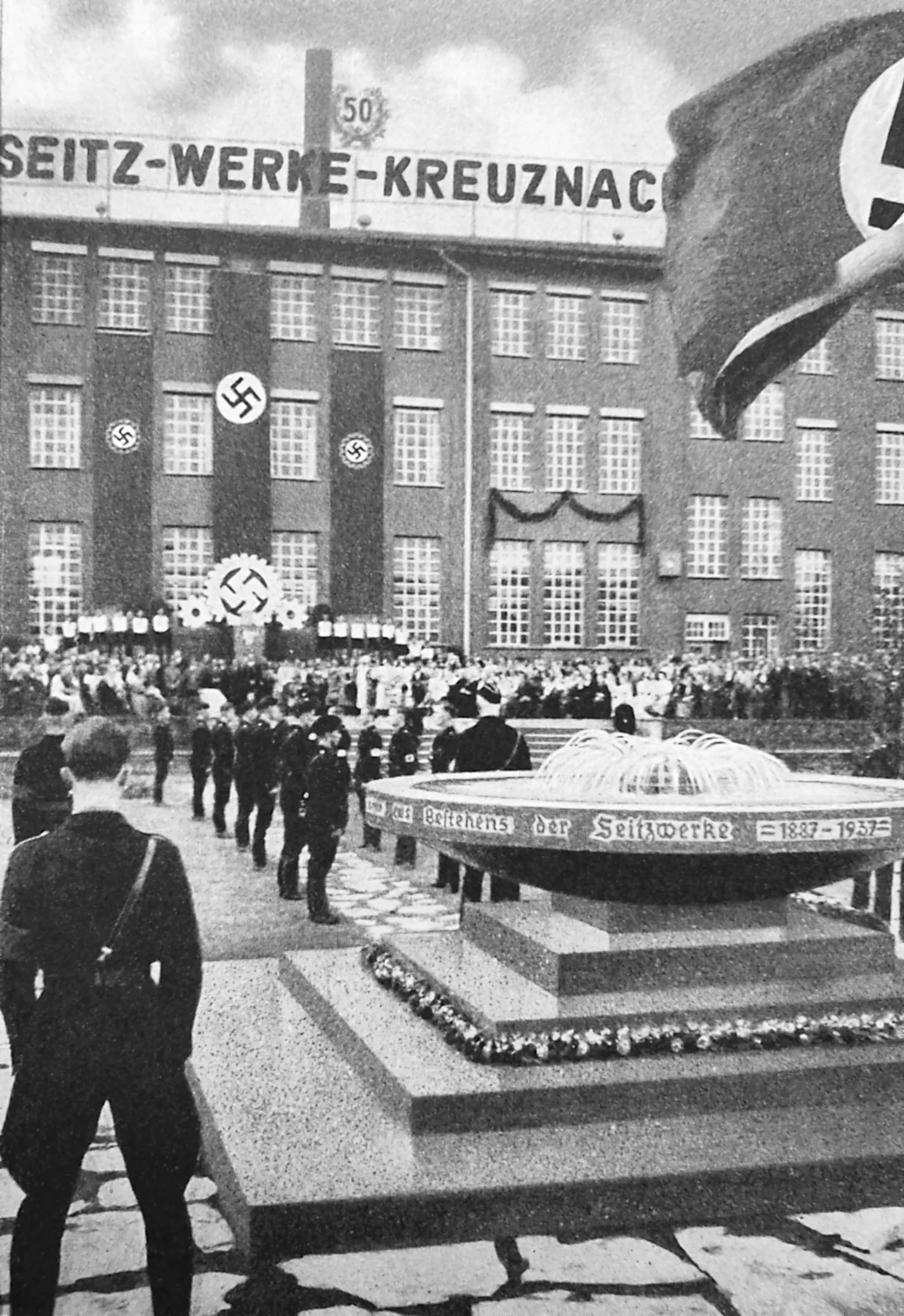
Dedication of a fountain designed to “tell future generations of the deeds and actions of the men it is dedicated to”: company founders Theo and Georg Seitz.
At the Seitz-Werke
in Bad Kreuznach apprentices were deployed as plane spotters in a tower on the roof of the main building from the end of 1944. They reported approaching squadrons of bombers once they were clearly visible and then escaped to the safety of the cellar.
Shells and bombs
Four years after the end of the war a certain Mr. Paul, who in December 1949 wrote his detailed memoirs of over 40 years as an employee of Holstein & Kappert, was able to say exactly which types of munitions were manufactured in Dortmund: “During the Second World War the company was active in the manufacture of shells, submarine conning towers, ships’ anchors, rings for vehicle trailers, bombs [and] roller conveyors for munitions factories,” he writes.
If we are to believe the deliberations in a book published in 1987 to mark the company’s 100th anniversary, during the Second World War the Seitz-Werke only made water sterilization filters for the Red Cross and “the fighting troops”. As this was a product vital to the war, parts of the factory had to be relocated to Hochstein in the Palatinate and Wels near Linz, for example. There is no mention in the existing sources of the production of any other munitions products.

To quote a contemporary brochure, at the apprentice workshops of the Seitz-Werke “not only are diligent skilled workers trained but also happy, cheerful people”.
Forced laborers
then called “foreign workers” – were usually prisoners of war, concentration camp internees and civilians in the occupied areas – and from 1940 also German Jews. They had to replace the workers who had gone off to war and keep war-time production up and running.
n September 1944 approximately nine million forced laborers and prisoners of war had to ensure the continued efficiency of the Third Reich’s national economy and compensate for the around twelve million German men away on active service at the front. In Dortmund alone about 45,000 non-German men and women – most of them from Ukraine – were forced to work in factories and mines and also in private households, public establishments and even church institutions. At Holstein & Kappert up to 150 of them were housed in barracks at the plant. At the Seitz-Werke in Bad Kreuznach sources assume that there were 30 forced laborers, with a similar situation at the Enzinger-Union in Worms.
The damages
German industry was less heavily damaged than is often thought – an important criterion for the rapid reconstruction of Germany.
Heavy damage
In November 1944 the Holstein & Kappert factories sustained serious damage during two heavy air raids on Dortmund, with about 80% of the complex destroyed. Here, Mr. Paul remarks that the air raid shelters built by Holstein & Kappert at the beginning of the war, claimed to be particularly exemplary, proved “totally insufficient” – not least because the then factory manager, “the most zealous Nazi in the company”, failed to have safe bunkers installed. When the air raid siren sounded, the workers ran off in all directions and sought shelter in neighboring bunkers or out in the open. Of the previous 600 employees just six were actively working to produce spare parts at the end of 1944; most of the others were fighting at the front.
Ten members of the company lost their lives. Unlike after previous air raids, it was no longer possible to make good the damage with temporary repairs so that production could continue. Photos of the site where the production shops once stood show a tangled mass of twisted steel girders, collapsed walls and roofs and damaged or destroyed machines scattered about the area.
Towards the end of the war the Holstein & Kappert operating division for dairy machines and equipment was evacuated to Zerbst in Saxony-Anhalt on the orders of the authorities. Not all of the wagons loaded with machines and valuable materials actually reached their destination, however. After the war the factory in Zerbst at first continued to operate under the name of Holstein & Kappert; the change in the political situation from 1962 onwards later left the Dortmund headquarters powerless to exert any influence. Other sections of Holstein & Kappert’s operations were moved to a machine tool factory which had not yet been destroyed, a Krupp plant in Neuenrade in the Sauerland and Dortmund’s prison.
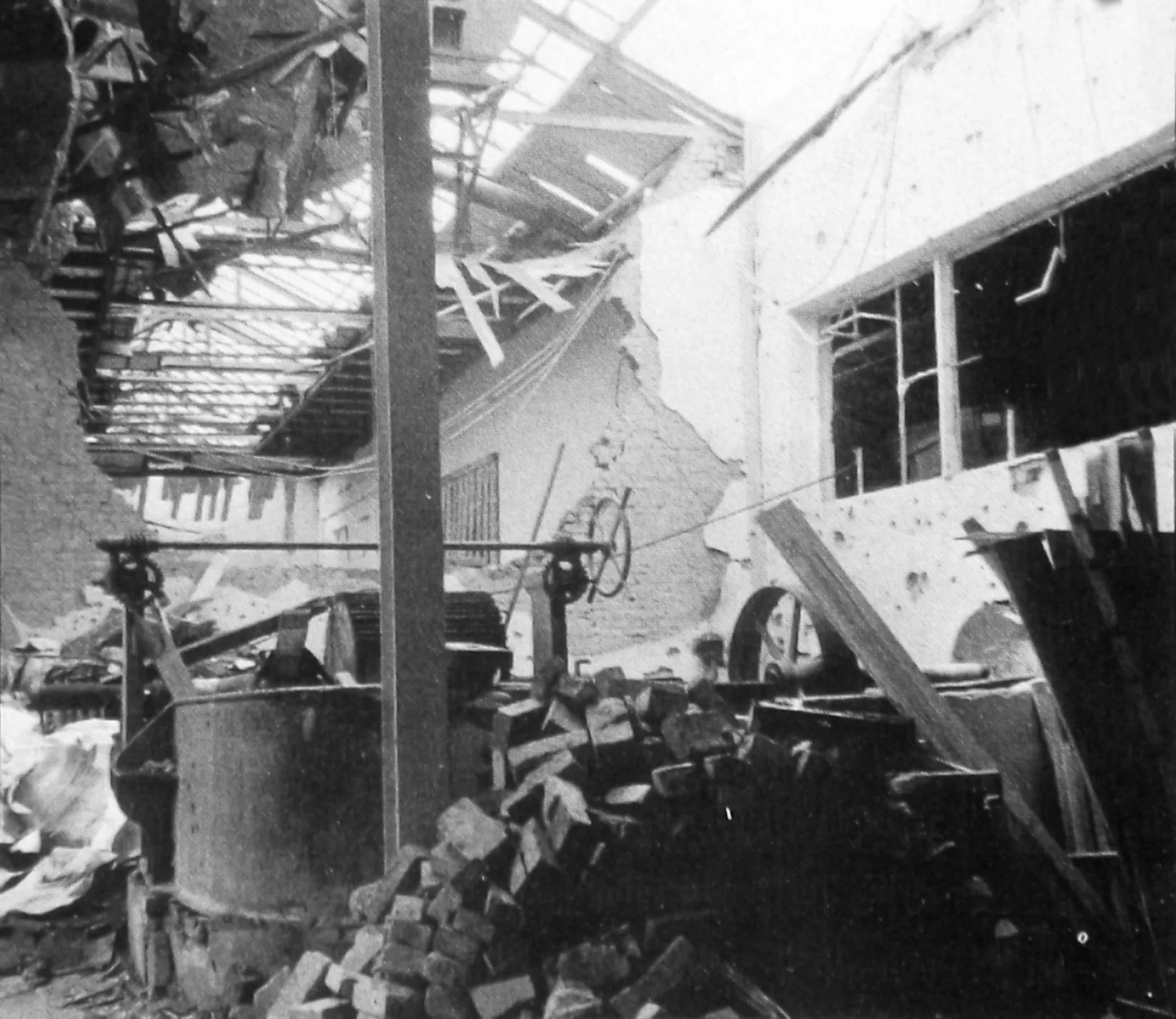
More than two thirds of the Seitz plant were destroyed in a heavy air raid in January 1945.
Almost nine million people
in the Third Reich had been evacuated by January 1945. About 840,000 of them had to leave their native towns and villages as companies were relocated.
Lost patents
In Bad Kreuznach the Seitz-Werke was hoping that it might have survived the war without suffering any significant damage when on January 2, 1945, the plant was the target of a heavy air raid. Two aerial mines, 35 high-explosive bombs and 53 incendiaries destroyed 80% of the factory. The main administrative building was gutted, with the company archives, valuable patents library and much of the model warehouse consumed by flames. In the anniversary publication of 1987 the author laments that “at the end of the war in the filter factory [one] had to stand helplessly by and watch as the only production line still functioning was dismantled and countless Seitz patents and property rights fell into someone else’s hands”.
The Enzinger-Union-Werke was also badly hit: in 1944 the factories in Mannheim and Berlin were annihilated and in 1945 the plant in Worms-Pfeddersheim was dismantled. In 1979 a brochure published to mark the company’s 100th year cites former senior master workman Reifenberg as saying: “1945: a factory destroyed, machines paralyzed, chaos everywhere. We entered a new age and at first carved out an existence for ourselves doing repairs for private households, making parts for stoves, oil presses and the like.”
In the aftermath of the war the word “compensation” began to circulate. Reifenberg explains in a simple example what was to be understood by this: “If a brewery needed a spare part, it first had to provide the bright metal for it. This meant that even splendid firemen’s helmets and other objects which antiques’ dealers would now love to get their hands on were melted down.”
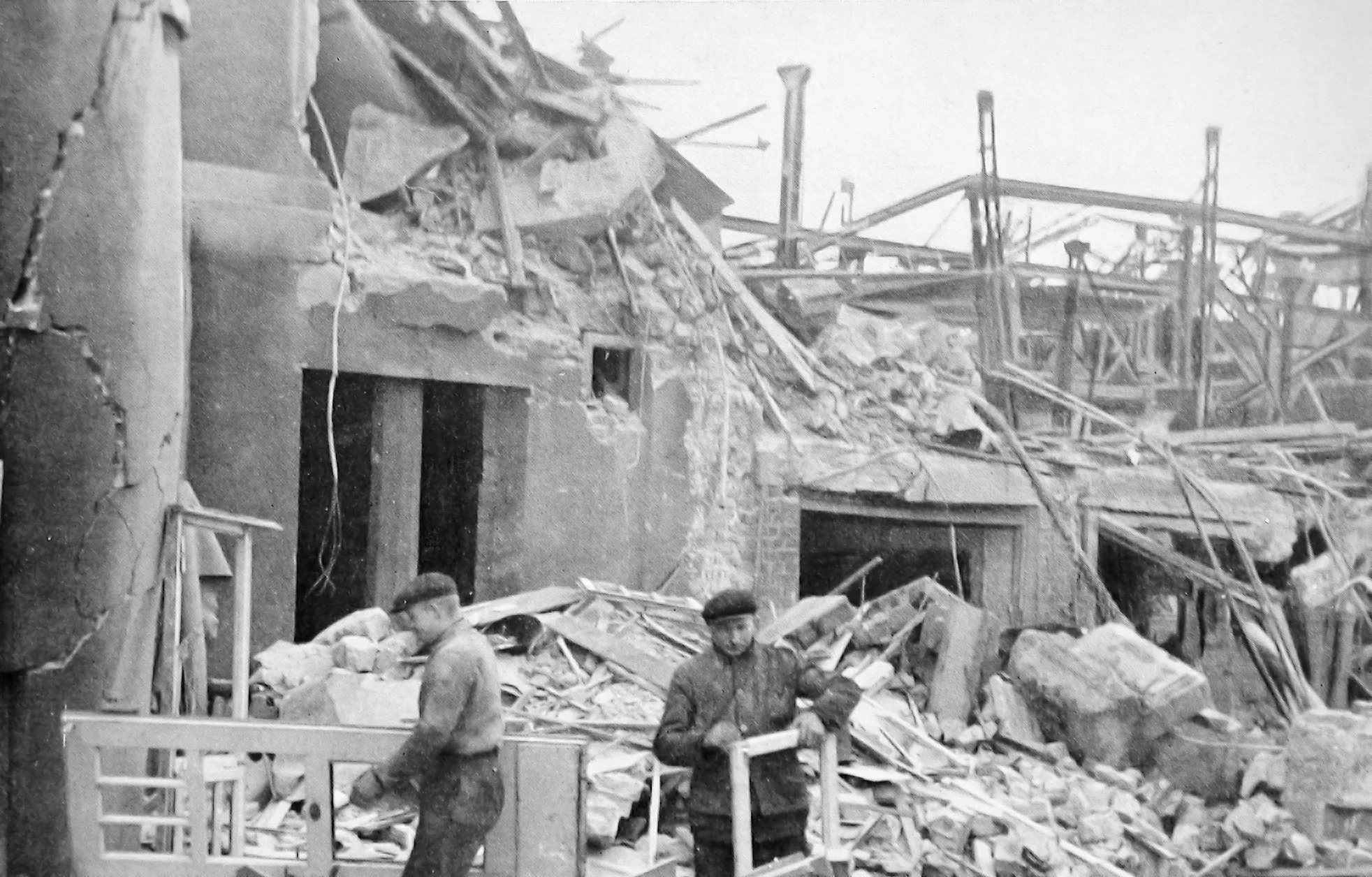
Workers from Holstein & Kappert in Dortmund clearing the rubble on the site on Juchostrasse.
95% of the historical center of Dortmund
was destroyed, much of it during the air raid of March 12, 1945, which is considered to have been the most severe conventional air raid on a European city during the entire Second World War.
Search for building materials
At Seitz everybody had to help to find materials to rebuild the factory. From head of the laboratory to sales representative the remaining employees scoured the countryside to “appropriate” stone, cement, roofing felt, tar and window panes in what were often adventurous circumstances. In the first years after the war necessity limited activities to initial repairs to buildings and workshops. Rebuilding only properly started in 1950 when as a result of the currency reform business gradually returned to normal. The last re-erected building wasn’t opened in Bad Kreuznach until 1955.
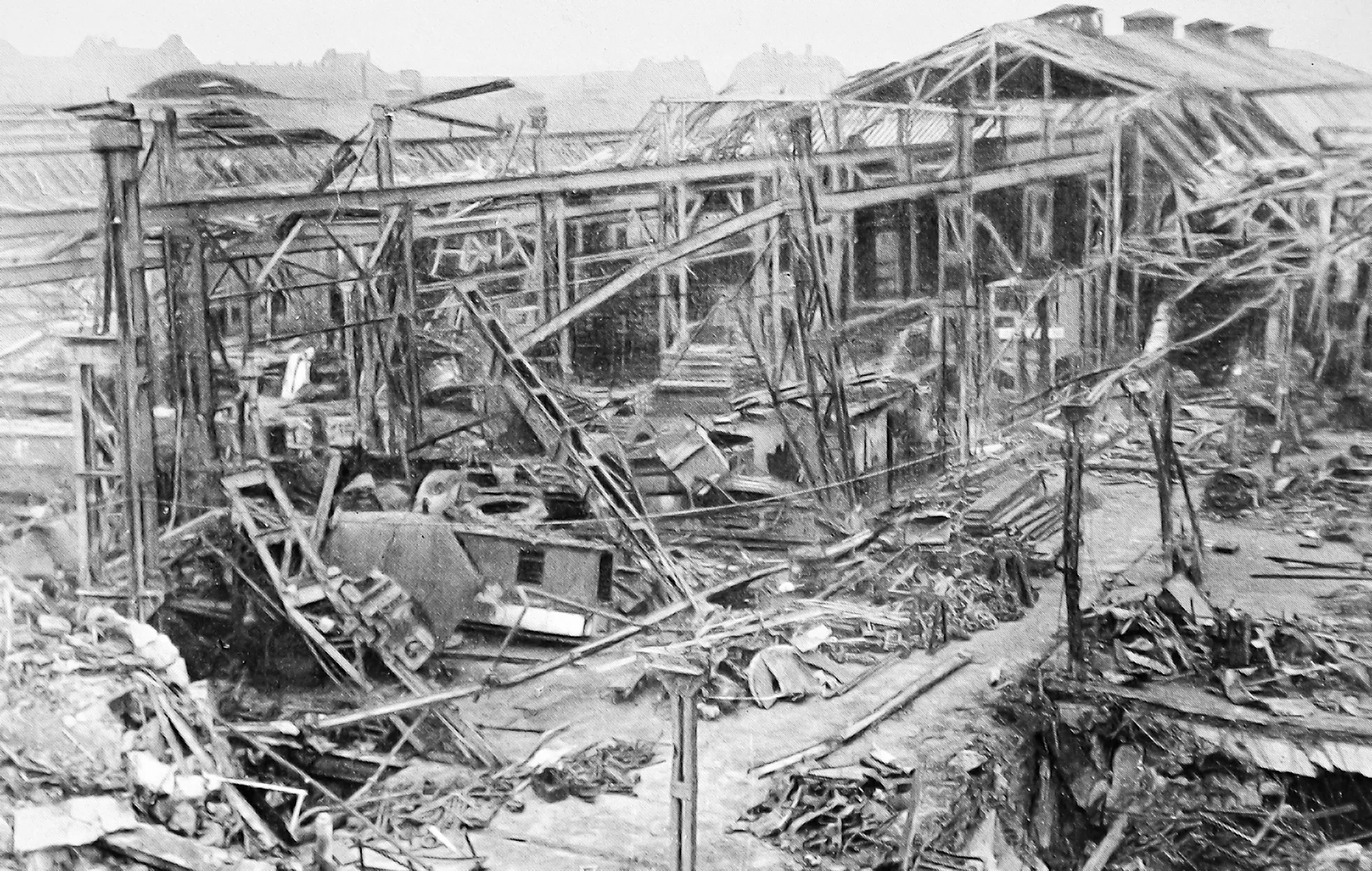
At the end of 1944 all that’s left of the Dortmund factory is an indistinguishable mass of rubble and steel.
After the Second World War
the victorious powers sought compensation for the damage inflicted and wanted to weaken the German military by demolishing its arms industry. Factories in the Ruhr were dismantled and handed over to the occupying Soviet forces in return for agricultural produce.
Rubble and scrap
In Dortmund 95% of the historical center was destroyed by over 100 air raids which unleashed about 23,000 tons of explosives on the city. It was even briefly considered leaving the rubble where it was as a memorial to the horrors of war and rebuilding the city at another location. As early as in May 1945 Holstein & Kappert received general permission to work from the occupying American forces and by the end of the same year they were granted a “special permit for the manufacture of dairy machines”. Before they could start, however, over 1,000 tons of rubble and 400 tons of scrap had to be disposed of – a massive undertaking in which the entire workforce took active part. In as far as we can speak of production at all under these circumstances, the company restricted itself to the manufacture of spare parts from existing materials. The production of small machines – which had not actually been in the product range for the last 20 years – was at that time a sign of remarkable progress. It was to take at least another decade until the forerunners of what’s now KHS were also able to benefit from Germany’s economic miracle.



